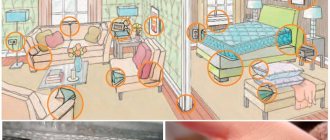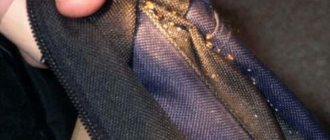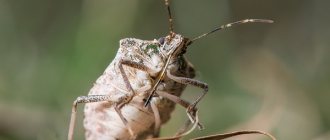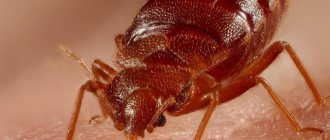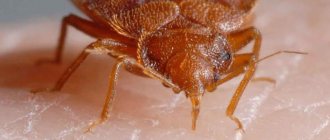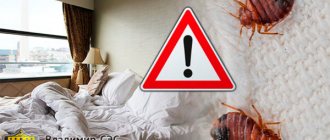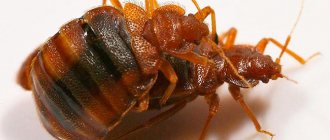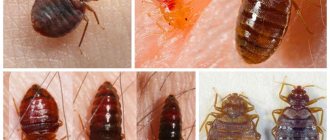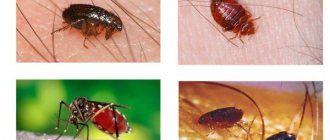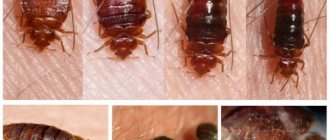Prevention measures
Dormitories, communal apartments, and nursing homes are the most common breeding grounds for insects. Bedbugs are classified as domestic arthropods, which means that they will only actively reproduce indoors.
- Before moving to a new place of residence, you must first treat the entire room and furniture and only then move in to live. You should also carefully inspect the furniture when you buy it second-hand.
- It is necessary to disinfect the entire premises after construction and repair work. Do not be afraid to demand that construction organizations eliminate all defects.
- High-quality whitewashing of ceilings, wallpapering and repair of cracks in the floor and wall is essential in preventing the infestation of bedbugs.
- As for your household routine, you need to do a deep cleaning with a vacuum cleaner and chemicals, change your bed linens frequently and periodically inspect your furniture and carpets to ensure that there are no pests in your home.
It is advisable to completely replace the floor, no matter whether it is linoleum or parquet. Because if bedbugs are found in the house, it will be very difficult to eliminate all the parasites from under the floor.
You also need to audit your belongings.
It is necessary to throw away things that you have not used for a long time. Otherwise, this is where furniture bugs can settle. It is necessary to clean shoes and outerwear with special aerosols to destroy harmful parasites.
Do not collect or bring into the house other people's toys, pillows, towels or bedding.
If you notice bed bugs in your apartment, don't be shy about talking to your neighbors about it. The sooner they can become aware of a possible problem, the sooner it will be resolved and, most likely, will not begin to scale. You can also try to get rid of bloodsuckers using electromagnetic waves and ultrasounds, which animals cannot tolerate.
Summarizing all of the above, it is important to say that all preventive measures play a big role in preventing the appearance of bedbugs. Only comprehensive care for your home, office and study will help you completely protect yourself from harmful insects, bedbugs and parasites.
Preventing home infestation with bed bugs
Bed bugs enter the home along with furniture, luggage and clothing, as well as from adjacent rooms through pipes and electrical wiring.
- Never bring into your home bed frames, mattress toppers, box springs, or upholstered furniture found outside.
- Check all used or rental furniture for bed bugs.
- When stopping overnight during a trip, inspect the bedding and furniture. Do not place suitcases on the floor or on the bed and be sure to check them before departure.
- If you suspect you have been in a bedbug-infested area, immediately wash and dry your clothing with hot air, or store it in an airtight plastic bag until you have a chance to wash it.
How to detect bedbugs in a bed
If the bed is iron, of an outdated model, then parasites do not live on such a structure. They prefer wood or textiles. On a wooden structure, insects usually settle inside: under the mattress, on the side walls, in the corners. You may also see red dots on the bedding or mattress. They are clearly visible on light-colored underwear. If the cover on the pillow is damaged, insects can get inside. However, pests rarely establish themselves here, for example, in cases of severe infestation, where little attention is paid to cleaning and changing bed linen.
There is a colony of bed bugs in hidden places of the bed.
Bed bugs - the easiest way to detect them
The parasites that have spread throughout the room already feel so unpunished that they sometimes do not consider it necessary to hide under baseboards or carpets, preferring to be closer to their victims.
How do you know if they are in bed?
By carefully examining all the seams and folds in the mattress and even pillows, you can find signs of bedbugs - excrement and parts of dead insects. It is not uncommon to encounter adult individuals hiding in a mattress, waiting for a night meal.
Sometimes, despite all efforts, nothing can be found, although residents are sure that bedbugs have already taken up residence in the room.
This is where white bedding comes to the rescue.
- Spread it on the bed, another sheet can be placed near the bed.
- After waiting until nightfall, suddenly turn on a bright light - if there are parasites in the bed, at least one of them will certainly reveal its presence.
Distribution routes
Pests do not form nests as such. However, they prefer to live in the same places. A cluster of insects has characteristic signs: the place looks extremely dirty and intimidating. In the so-called nest, adults scurry about interspersed, the larvae are adjacent to the eggs from which the nymphs are about to emerge, their own excrement and the chitin that remains after the “molting”. But where do bed bugs come from that cause such discomfort to humans? There are four main reasons for their appearance in an apartment.
- Tourist trip. Until the beginning of the twentieth century, the topic of bedbugs was never discussed at entomological conferences, but with the development of tourism, the parasites were finally talked about. In fact, the development of a tourist destination led to people taking insects to different parts of the globe. When staying at a “bedbug” hotel, know that you can also bring a “present” from your trip in your own suitcase.
- Migration from neighbors. If your neighbor has bedbugs, then they will most likely appear in your apartment sooner or later. This usually happens as follows. The neighbor gets tired of living side by side with annoying pests, he unsuccessfully poisons them, but does not achieve total elimination. Bedbugs quickly migrate in search of a more liberal climate. For example, to your place - where no one uses any chemicals yet. During the cold season, parasites move through ventilation shafts. In warm weather - along the external walls of the house. Therefore, mosquito nets on windows are one of the ways to protect against blood-sucking parasites.
- "Hello" from the guests. Bed bugs can live in clothing, and they can also use it to move from one place to another. You can carry insects in your own jacket pocket on your way back from a party. The reason for the appearance of insects in the house can be a guest who brought them in a fur coat, jacket or back pocket of trousers.
- Proximity to a farm or poultry house. Blood-sucking parasites often move into the houses and apartments of people living near farms. Farms with goats, sheep, rabbits and chickens are their habitat. But arthropods prefer human blood to animal blood, so they happily “move” when they smell “upright food.”
Information about bed bugs was first discovered in a source dating back to 400 BC. Later, these parasites were mentioned alternately by Aristotle and Pliny. The latter assured that the pest’s bite could neutralize snake venom.
Signs of the presence of a household parasite in the house
The most important signs of presence include bite marks and bloody stains on bedding . If you doubt that it is these parasites, look for other signs of presence.
When searching, special attention should be paid to the area next to the sleeping place - inspect the back of the furniture, cracks and cracks, and the floor.
You can also quickly throw back the blanket at night and turn on the light. You will notice bed bugs on your bed or your body, although they will quickly begin to scatter.
How long do bedbugs live in ideal conditions?
The average lifespan of pests in an apartment where it is warm, moderate humidity and always has access to food (the most suitable habitat for them) is 10-12 months. But this value changes under the influence of various factors. When it gets cooler, the parasites that live here go into a diapause phase. All processes in the body slow down, which helps to increase life expectancy. In extreme heat, acceleration of all reactions is often observed. Life expectancy is reduced to 10 months.
In the cold, bedbugs enter a diapause phase
Option for living without food. No blood in an empty apartment
There are no exact data. Terms with a wide range are called: from 3 months to 2 years. The reason for this run-up is that the duration of this period is influenced by a large number of factors, among them: air humidity, temperature. Such insects can indeed survive in the absence of a food source, so this control method should not be considered.
Bed bugs can live without food for up to 2 years
After processing
They take into account what dose of poison the parasite received. In addition, nest detection provides a guarantee of treatment success
In this case, after treatment it will not be possible to get rid of the insects; they will live for a long time until they die a natural death. If the hot or cold fog method was used (when the toxic substance penetrates into all corners of the house), the death of the pests will occur over the next few hours, less often - in 1 day.
Where do bed bugs hide in the house?
Typically, bedbugs look for secluded places to wait out daylight hours in close proximity to food sources. Often these insects can be found on the frame under the mattress, under bedding. They can also accumulate in the gap between the bed frame and the mattress. Refuges for bedbugs include:
- cracks in the walls;
- space under the wallpaper;
- grooves in cabinets;
- cloth;
- books;
- Appliances;
- upholstery seams.
This is not a complete list of places where these insects can hide at all times of the day. This feature makes them invisible. Some housewives who carefully monitor cleanliness, even during general cleaning, may not identify where these creatures accumulate in the house.
Most often, bedbugs hide in beds, bedding, and furniture crevices.
Once the insects are detected, a stubborn fight against bed bugs begins. This process is very labor-intensive, but if desired, you can quickly get rid of these parasites.
Special signs????
When a room is infested with bed bugs, you can navigate by one of the manifestations of the parasites. This is due to the fact that each of the signs differs from traces of contact with mosquitoes, fleas, lice and other blood-sucking insects
However, sometimes you need confirmation of your own fears, so pay attention to other signs
Characteristic bites
This is the main sign of bedbugs in an apartment, since it can be noticed immediately after an object is infested. For comparison, other manifestations become visible only after some time. Contact with bed bugs produces red spots of varying sizes. Some people do not have such a symptom; only invisible red dots remain on the body.
Bedbug bites can be easily distinguished from the bites of other insects.
Other symptoms of bed bug bites:
- itching, and its intensity is quite high, and scratching occurs on the body;
- swelling, as a result of which bumps are found in the areas where the bites appeared, but without compaction inside, the intensity of the swelling depends on the sensitivity of the body;
- the size of the red spots varies from 0.5 to 5 cm, and the tracks of the bedbugs form a straight line - a path, since the parasite makes several punctures per meal, moving forward every few centimeters.
Other symptoms appear less frequently: pain, fever, headache, chills.
Chitin shells
There are many signs of bedbugs appearing in an apartment, but in second place is the detection of husks, which are shed by the larvae after each molt. A young individual of the pest changes its shell up to 4 times. This happens at different intervals - from 7 to 14 days or more, depending on environmental conditions. The shell can be seen on the floor or other surfaces, as it is distinguished by its light brown color. Moreover, the outer covers are transparent.
Chitinous shells shed by bedbugs during molting
Clutches of eggs
A female bedbug lays up to 5 eggs per day. To provide the offspring with protection, she leaves them not only in the nest, but also in different parts of the room. If one clutch is destroyed, for example by human discovery, the remaining eggs remain intact. The offspring at this stage look like small white formations - up to 1.5 cm in length. On one side there is a lid that allows insects to escape from the shell when necessary.
Clutches of bedbug eggs: not a single infected object can do without them
Specific smell
If bed parasites have only recently appeared, this sign is absent. The smell is felt when the number of pest colonies increases to several hundred individuals. This is a consequence of the vital activity of parasites. They leave excrement and secrete other secretory fluids in minimal quantities, but as the number of insects increases, a large amount of excrement accumulates in the apartment, which contributes to the appearance of a smell reminiscent of old cognac. If you stay in the room for a long time, you won’t feel it.
The specific smell of bed bugs is a guarantee that there are insects in the apartment
Blood stains
Such signs of bedbugs are also detected if there are a lot of parasites at home. Dots or small specks of blood appear on the bed if a person accidentally crushes the parasite in a dream. This occurs due to an increase in the volume of the insect’s body after eating. As a result, the parasite is much easier to kill. His body becomes more pliable and breaks easily. For comparison, in a hungry state it is more difficult to destroy a pest mechanically.
Blood stains from squashed bedbugs remain on the bed
Traces of bedbugs on the wallpaper
If red spots remain on the bed linen, then on the finishing materials only stains from excrement, as well as other secretory fluids of parasites, appear to a greater extent. You can see traces of a bug on the wallpaper when the insects have built a nest in the area where the material has moved away from the wall. Parasites penetrate under any covering.
In particularly infested areas, traces of bedbugs are even present on walls and wallpaper.
Vital signs
When parasites colonize an apartment, black dots are found on different surfaces, and more often in areas where nests are located. This is parasite excrement. Bed bugs feed on blood, which is why the stool turns dark. The blackheads are small in size, which is why they resemble poppy seeds. The larger the pest nest is, the more things deteriorate in the area where it is located.
If furniture is infested with bedbugs, it is practically beyond repair.
Bites
The most obvious sign of bed bugs is bites. Bedbugs are blood-sucking pests; they feed on the blood of animals and humans. They are nocturnal and go out hunting at night. Bite marks can appear on any part of the body, but areas with the least thick skin are preferred for parasites - in the elbows, on the neck, buttocks, and arms. A characteristic sign indicating that a person was bitten by a bug and not a mosquito is a trail of bites. A bug requires up to 7 ml of blood to saturate; it feeds on capillary blood, that is, after one puncture of the skin, it may not have enough food, which means it makes the next bite.
Bedbug bites themselves may not bother a person. The itching that appears at the site of the bite is irritating. Some people have very severe allergic reactions. The bite marks themselves are red spots with a dot in the middle. They may swell. If there are a lot of bedbugs in an apartment or house, then they can make up to 400 bites per night.
Bedbugs bite everyone, but most often their victims are children and women. This is due to the fact that they have thinner skin. But if bedbugs appear in the house, then bite marks will be on all family members. They also bite domestic animals, but much less often, because the skin of dogs and cats is much denser than human skin. In addition, it is believed that bed bugs feed exclusively on human blood, and animals have their own ectoparasites.
If characteristic marks appear on the skin, it is worth observing them. The bites themselves are not dangerous; they pass quickly enough. But these insects are carriers of dangerous diseases, so they can infect the victim. They can be especially dangerous for children and elderly or weakened people. If bites are detected, it is necessary not only to clean the home of pests, but also to pay attention to the health status of the residents.
How to detect bedbugs in an apartment
Bed bugs can get into an apartment by accident on clothes or shoes, with a book brought in, a suitcase from vacation or any other thing that has been in their habitat, as well as from neighbors.
But most often, apartment owners receive such an unpleasant surprise along with furniture, often used, but sometimes new. In most cases this is a sofa or bed, sometimes a mattress.
On the very first night spent on infested furniture, you can be attacked by parasites. Itchy red spots are generally similar to mosquito spots, but have a characteristic location - they go in paths of several pieces, at a distance of about 2-5 cm from each other.
Inspection of bed linen
If suspicious bites are found on the body, you need to inspect the bed linen: when bedbugs bite, they inject a substance into the wound that prevents rapid blood clotting, so small blood spots remain on the fabric.
When examining the bed, you can also find bedbug excrement (small black-brown grains), and sometimes the crushed insects themselves. Pillowcases and duvet covers should be turned inside out to check.
How to Detect Bed Bugs in a Mattress and Bed
Even if insects and traces of their presence were not found in the bed linen, you need to carefully inspect the mattress (especially the corners and joints of the seams) and the space under it, and if the mattress has a removable cover, look inside its structure.
To check the bed, the mattress must be removed from it, and the legs, frame corners, joints of structural elements, all gaps, grooves, technological holes must be carefully inspected.
How to find bedbugs in upholstered furniture
To inspect sofas and armchairs, you need to remove soft elements and armrests, pull out linen closets and mechanisms for transforming the berth. Insects can settle in the joints of frame elements and under the upholstery, especially if the integrity of the upholstery is damaged in places and the furniture has a spring unit (in this case, there are many suitable voids inside for parasites).
Where to look for bedbugs
Bed bugs can settle in any furniture (upholstered and cabinet), as well as in books, watches, paintings, household appliances or electronics, in the floor and walls. Objects thoroughly infested with bedbugs emit a specific smell, which, as a rule, does not escape the sense of smell.
A multiplying colony infects the entire apartment, moving from place to place. To detect all parasite nests, you need:
- remove clocks, paintings and other wall elements from the walls;
- look under carpets and rugs, examine the pile itself;
- move cabinet furniture away from the walls and inspect the rear walls;
- remove baseboards and sockets;
- check areas of peeling wallpaper;
- check the floor covering, inspecting the gaps, and if there is linoleum on the floor, lift it from the edges;
- inspect household appliances and electronics;
- Use a flashlight to shine a light through any suspicious cracks.
On walls, floors, bed legs and other surfaces, bedbugs leave dark dots and paths along which their paths of movement can be calculated. Accumulations of excrement can be seen near the entrances to parasite shelters.
When inspecting cabinets, you need to remove all things and especially carefully inspect the corners and joints of structural elements. Clothes and fabrics lying in piles need to be unrolled and shaken, books need to be opened and the pages examined. Household appliances and electronics should be checked internally by looking under the housing.
How to find bedbugs in an apartment
If it is not entirely clear where bedbugs are hiding, and whether they are even in the house, you can install homemade or purchased adhesive traps near the expected places of their settlement - several individuals will definitely be caught in them.
If no insects were found in the bed or mattress, they probably made a nest elsewhere in the apartment, and climb onto the bed along the footboard or headboard (these insects cannot fly). To ensure their presence, glue traps should be installed on the floor around the perimeter of the bed, and if the bed has legs, around the legs.
Another way to detect insects is to suddenly turn on the lights in the apartment in the middle of the night and inspect the bed. If you use white rather than colored bedding, insects will be much easier to spot.
If insects are found, you must immediately begin to combat them by treating with disinfectants all the places where bedbugs live, and better yet, the entire apartment.
The nuances of searching for bedbug nests
The efficiency of today's insecticides is so high that it ensures the elimination of bed bugs even when carrying out the treatment on your own. It should be remembered that preventing the re-spread of insects in the apartment requires the death of adults, larvae and eggs laid in nests. The latter are especially well protected, which is explained by the presence of a special shell that prevents the insecticide from penetrating into the egg.
The easiest way to destroy bedbug nests and eggs is by a combination of chemical and mechanical methods. But this requires finding them first. Let's consider the problem of how to detect a bedbug nest. Finding the right solution involves taking into account the peculiarities of choosing a place for nesting by domestic parasites:
- proximity to a person, that is, food. The bed bug feeds on blood, but does not have a serious speed. As a result, we can unequivocally state that both the nest and the bug should be looked for nearby in a place to sleep;
- secluded location. The bug chooses the most hidden places in the apartment to lay eggs and build nests. They are used as shelter during the day and by adult bedbugs. This approach to arranging nests makes it difficult to find the parasite and reduces the chances of finding adult bedbugs or eggs laid by a female insect;
- comfortable temperature. It makes no sense to look for bedbugs in cold and poorly heated areas of the apartment. The optimal temperature range for an insect provides a parameter value ranging from +25 to +35 degrees. This leads to an obvious conclusion: it is easiest to detect a bug and the nests it makes in well-warmed areas of the apartment, and not in a drafty room.
The photo was taken while searching for nesting sites for house bugs in the customer’s apartment. This is a nest in the folds of the fabric of the sofa. The white grains are eggs that were about to hatch.
Finding a bedbug and its nests in an apartment in a residential building is the first step in solving the problem of an unpleasant neighborhood. The second stage involves the destruction of insects at all stages of the life process, including eggs laid in nests, larvae and adults.
Today's Russian market offers a wide selection of effective insecticides. The range of preparations is steadily expanding, and the following are considered the most effective against bedbugs and insect nests:
- Karbofos;
- Get Total;
- Xulat Micro;
- Dobrokhim FOS;
- Medilis Cyper;
- Avalon;
- Ecokiller and others.
In order to eliminate bedbug nests, it is advisable to combine the use of chemicals with conventional mechanical methods of insect control. This approach minimizes the need for repeated insecticidal treatments and reduces the likelihood of parasites appearing a second time. The main thing is not only to find bedbugs and locate their nests, but to strictly follow the rules for the practical use of the insecticide chosen for treatment. The picture below shows the appearance of the packaging of modern house bug exterminators. This is what the boxes of medications that contain bottles of liquid concentrate look like.
The most effective bed bug remedies for 2021
Other methods of struggle
It is usually impossible to get rid of insects using various folk methods, using tinctures or strong-smelling herbs, but “turpentine” and “denatured alcohol” can ruin the sofa forever and naturally, no one will do this, especially if the bugs came from the store together with a new sofa. The most effective and reliable way to get rid of parasites is to treat the sofa by specialized pest control services; this has always been the case and will always be the case.
It is a mistake to assume that you can get rid of insects by leaving them hungry for a while by moving out of your home. Bedbugs can wait a long time for the owner to return and lay eggs during this time. Therefore, if bedbugs have settled in the sofa, the problem needs to be solved radically and urgently, right up to getting rid of your favorite sofa, since in addition to the bites and diseases that they can cause, these are also very unpleasant insects that cause disgust, as you can see with one look at the photo.
Traces on the bed
On the bed, traces of bedbugs are visualized in the form of bloody spots formed after a parasite bite when blood oozes from the wound. Usually they are minor. But if you crush the bloodsucker, the stain can be large.
On the bed you can find chitinous membranes after molting nymphs and feces of parasites . These are clear signs of bedbugs in the apartment. If they are found, you should carefully inspect the apartment.
Important. During baiting, bloodsucker eggs do not die, since the protective layer protects the insect’s body. To completely get rid of pests, repeat disinfection is carried out after 1-2 weeks.
It is very difficult to remove bedbugs from your home, since adult bedbugs live for about a year, and during this time they can lay up to 500 eggs. Under unfavorable conditions, the parasite can go into suspended animation, which then extends its lifespan.
The most effective method of control is heat treatment of the room.
The most common habitats of bedbugs in an apartment
Bed bugs are unpretentious and tenacious insects. They feed exclusively on blood, biting their victims mainly between 2:00 am and 7:00 am. The choice of a place to build a nest for these parasites is explained by their lifestyle and nutritional needs.
Parasites need very little to survive:
Food availability
Bedbugs feed mainly on human blood; in the absence of it, they can also bite animals. But they are not capable of parasitizing directly on human skin or in the fur of pets. Once every 5-10 days, the bug leaves its shelter to drink blood, and then returns almost immediately.
These parasites move relatively slowly (about 1 meter per minute) and are guided by the smell and warmth of the victim’s body. From which it follows that the most preferred habitats for bedbugs are in the immediate vicinity of the place where apartment residents spend the night:
- sleeping places (beds, sofas, mattresses) – this is where bedbugs settle in the vast majority of cases;
- bedside tables and other furniture, bedside rugs, wall decor, clocks and shelves above the beds;
- cracks in the floor and walls near the sleeping areas.
Bedbugs often settle in closets, especially wardrobes, attracted by the human body odor from clothing. There have been recorded cases of detection of nests of parasites in computer keyboards (probably, bedbugs are attracted here by the smell of fingers on the keys).
Parasites can make a nest in the bedding or house of a dog or cat. But if we talk about pets, then more often bedbugs settle in the cages of birds and rodents - their skin is thinner, it is easier for a bug to bite through it than a dog or cat.
Suitable temperature
Bedbugs, although they are able to survive at temperatures up to +50 °C and down to -22 °C, love warmth very much. The best option for them is a room temperature in the range of 20-30 °C; it is in such conditions that they feel great and reproduce most quickly. Therefore, for example, in winter, bedbugs can hardly be found on an unheated balcony or in the cracks of window frames.
In an apartment where it is equally warm in winter and summer, multiplied bedbugs can settle everywhere. If the house is relatively cool in winter, insects are “stationed” in the warmest corners of the home - in beds and near elements of the heating system; they can make a nest in the computer system unit, TV or other equipment.
Secluded safe places
Bedbugs have a flattened body, thanks to which they are able to penetrate into the narrowest crevices. These parasites make nests in corners of the apartment protected from light, where nothing disturbs their peace. They feel most comfortable in such shelters, where they simultaneously touch surfaces with their belly and back.
Here's where bed bugs live:
- under the mattress or in the mattress itself, especially if it is multi-layered (has a spring block, mattress pad, layers of coir);
- inside sofas and beds, in the gaps between structural elements;
- in cabinet furniture;
- in piles of clothes and other fabrics, mostly natural;
- in narrow crevices of walls, floors, floor coverings;
- under carpets and rugs, in pile;
- behind peeling wallpaper;
- in sockets;
- on bookshelves and in books;
- behind wall clocks, paintings and other decorations;
- in the spaces between the back of the cabinet (or chest of drawers, cabinet) and the wall;
- in household appliances and electronics.
In the photo there are insects and their excrement on the wall
Why don’t bedbugs live directly in bedding, since they are still forced to constantly crawl into the bed of a sleeping person? Because it is far from safe for them. Firstly, parasites always try to remain unnoticed, and secondly, a bug that has drunk blood becomes vulnerable - its swollen body is easy to crush, which happens from time to time when the bitten person begins to toss and turn and itch.
The only element of bed linen that these insects sometimes inhabit is the pillowcase, or rather the space between the pillowcase and the filling. A bug cannot live in the pillow filling itself, since it is not able to move and breathe normally in such a dense mass.
It is noteworthy that insects that have settled in a wardrobe choose stacks of clothes to build their nests, rather than things hanging on hangers (it is inconvenient for them to be here). Parasites can also make nests in piles of bed linen, towels and any other fabrics.
Checking for bed bugs
- check top mattresses and bottom box springs, bed frames and bedding;
- Inspect the top and bottom seams, quilting, and any openings in the covers of the top mattresses and bottom box springs;
- look under the bed and inspect the surface of the bed frame and headboard;
- inspect cracks and cracks in bedroom furniture, floorboards and baseboards, window and door frames;
- remove and check zippers, seams and cushion padding of upholstered furniture;
- remove drawers from the furniture and check their internal, upper and lower surfaces, joints, as well as screw holes;
- Use a putty knife or an old plastic or playing card to go over all the cracks and cracks, displacing the bedbugs hiding in them.
This procedure can also be performed using a jet of hot air from a hair dryer operating at low speed. If bedbugs emerge from the cracks, crush them with a paper towel and dispose of them outside the building.
- check the walls and objects hanging on them;
- check for cracks in plaster and peeling wallpaper;
- inspect the front panels of sockets and switches (visually only);
- look inside phones, watches, smoke detectors and toys.
Inspect the area for bed bugs, blood stains, feces, and insect eggs (you can use a flashlight and a magnifying glass to do this). Start by examining an area within a radius (3-6 meters) of where you sleep or sit. Typically, bedbugs travel this distance.
More details about where bedbugs come from and how to fight them?
Bed bugs climb onto mattresses, pillows and upholstered furniture (we found out the reasons for their appearance in a person’s home above) from the floor, fleecy carpets, and animal fur. Smelling the smell of food, the parasite begins the process of nesting nearby its “prey”. This is how bedbugs get in residential premises - they look for a secret fold or lapel and hide there. After making sure of the safety and availability of food, they begin the breeding process. The same applies to furniture and linen items. When there is a lull in the night, the predator goes out to feed. It finds the victim by smell and drinks its quota of blood within 10 minutes. Having found out what causes bedbugs in the apartment, we will figure out how to get rid of them using strong industrial insecticides.
An insecticide is a toxic substance that destroys the chitinous cover of an insect and penetrates its respiratory system. The drugs paralyze the pest, which leads to suffocation. Having determined the signs and causes of bedbugs in an apartment, let’s consider how to get rid of them with ready-made preparations:
- detect places where pests accumulate;
- clean the premises;
- treat areas where parasites are localized with an insecticide;
- treat all comfort zones in the house;
- after some time (depending on the number of bedbugs, how pests appear in the apartment, and the chosen product), wash the premises, removing dead insects;
- reapplying insecticide to comfort zones.
It doesn’t matter where home bugs come from and why, rooms will have to be treated with ready-made insecticides 2-3 times. Perhaps more. The fact is that household preparations are not as aggressive as professional products, and therefore do not affect pest eggs. So that after 1-1.5 weeks you don’t have to wonder why bedbugs appear in the apartment after disinfection.
The drugs must be used strictly in accordance with the instructions. It is not recommended to use them without personal protective equipment. It is also worth remembering that with a significant pest population, even strong household insecticides will not help. Therefore, it’s not worth spending time figuring out where bedbugs come from in an apartment and how to get rid of them. It’s better to call an exterminator right away.
Store shelves offer a lot of ready-made products. But not all of them are safe and effective. Strong insecticides are best used in a house where people will not live for the first time after treatment. You should also carefully consider the choice of drug if there are allergy sufferers, small children and pets in the house. Effective drugs against bedbugs, how to fight them using them, are described above:
- Executioner and Gektor;
- Empire and Insect Control;
- Cimex and Cifox;
- Delicia and Ecokiller;
- Get and Tetrix;
- Agran and Reid;
- Combat and Delta Zone.
These are not all drugs, but they are the most convenient to use and effective. If their use does not help, and you do not know how bedbugs appear in the apartment again after self-disinfection, contact a specialist. Remember: human ectoparasites are carriers of serious diseases and create an unfavorable microclimate in the house where a person lives.
Source
Cleaning and disinfection
Get rid of unnecessary items to reduce the number of places bed bugs can hide. Check for bed bugs in unwanted items and think about where you can store these items until the pests are completely eradicated from the house. Check all items again before returning them to their original location. Remove dead bed bugs, blood stains, eggs, and insect droppings using hot, soapy water. Rinse all items with bed bug stains in hot water and dry them on high for at least 20 minutes. Once dry, store items in sealed plastic bags until you are sure you are completely free of bed bugs. Vacuum carpets, floors, bed frames, furniture, cracks and cracks daily using a brush and crevice tool. After each use of the vacuum cleaner, empty the dust bag or seal it and dispose of it outside the building.
Before the arrival of the disinfectant instructor, you must:
- Disassemble things, remove or pack unnecessary items, remove or isolate bedbug killers from getting on dishes, personal hygiene items, cosmetics, clothes and underwear (if you suspect the presence of insects in underwear or clothes, they must be washed), isolate food and drinking water from possible contact with the product.
- Carry out a thorough wet cleaning of the entire room, wipe all surfaces from dust, get rid of debris, organize free access for the instructor-disinfector to all areas of the treatment facility and to all pieces of furniture.
- If treatment for bedbugs is carried out, it is necessary to remove all bedding for subsequent washing, prepare pieces of furniture for treatment, disassemble as much as possible the pieces of furniture infested with bedbugs in order to thoroughly treat their internal surfaces, moving them away from the walls where possible.
- When treating for fleas, you must thoroughly wash all animal bedding (if any).
- When processing, it is necessary to remove pets, birds, and aquarium fish from the premises.
- At the time of treatment, no one should be in the room except the instructor-disinfector conducting the treatment and the customer’s representative (the instructor-disinfector has a protective mask with him and provides it to the customer’s representative for safe breathing).
- After treatment, you must leave the premises.
- The minimum time after which the treated room can be used again is 1 hour when treated with microencapsulated preparations, the optimal time is 8-12 and 24 hours (depending on the preparations used). Therefore, when deciding on the treatment time, calculate everything so that you can leave the room after treatment for the maximum possible time for you and your loved ones.
- Premises treated with the product cannot be used until they are cleaned, which is carried out no later than 3 hours before using the facility for its intended purpose.
- After you return to the room, you need to ventilate all treated rooms for at least 30 minutes, thoroughly wipe tables and other surfaces using rubber gloves with a damp cloth with a soda solution (30-50 g of soda ash per 1 liter of water). But you should not carry out a complete cleaning of the room in all hard-to-reach places, since in this case you will wash off or sweep away most of the applied drug, which can lead to incomplete death of insects and a relapse of their re-spread.
Why do bedbugs appear in the house?
First of all, bedbugs appear in the home where there is unsanitary conditions. Despite this, these bloodsuckers can appear in places where it is clean, cozy and warm. This is due to the fact that bedbugs can enter any apartment in various ways. To avoid bringing such parasites into your home, it is enough to take into account a number of factors. For example:
Bedbugs can appear if you purchase new furniture in a furniture store.
Particular attention should be paid to purchasing used furniture. In this case, the parasites will easily move to new residents. They can simply enter through cracks from a neighboring apartment or simply from the street. When buying old antiques, there is a high probability that bedbugs may appear in the apartment along with them. When buying things at a flea market, everyone runs the risk of bringing these parasites home with them, especially since it is not so easy to detect them in used items. You can just as easily bring them back from travel.
As a rule, bedbugs are a must in inexpensive hotels. Therefore, after visiting one of these hotels, it is easy to bring home these blood-sucking insects.
Specific smell
The first signs of the appearance of bedbugs are also associated with a characteristic smell, which intensifies in the apartment every day. Insects are guided in their activities by the sense of smell and themselves have scent glands. They notify relatives about the location of a power source or danger. The work of the glands is activated during the mating season.
On a note!
The aroma from one bug is extremely weak; humans cannot detect it. If the smell is quite strong, it means there are already a lot of parasites in the room. The mating season is in full swing.
The smell of bedbugs in the apartment is reminiscent of rotten raspberries, cheap cognac, and almonds. Some people start to smell like banana. The aroma intensifies with the onset of darkness, since at this time of day the parasites begin their active life. If a specific aroma is constantly present, the number of bedbugs in the apartment amounts to several hundred individuals.
Do bedbugs have a smell?
This is a specific question that depends on the type of insect, the subtlety of a person’s sense of smell and his special makeup. Wild bugs that live in the forest, in the garden and in nature have a strong odor and stink when you crush them. Whether bed bugs smell is another matter. Experts say that a strong, rich smell can only be felt if there are a lot of parasites and they have been multiplying for a long time.
Stagnant waste products, larvae, dead bodies - all this forms a layer inside your bed and can emit an unpleasant odor, reminiscent of many things at once. These are raspberries, cilantro, parsley, wood, excrement, cognac, peanuts - there are many associations. It is impossible to derive the formula for the true smell - it completely depends on the type of insect, its habitat and the number of individuals in one place.
Do not rush to draw conclusions about the presence of blood-sucking parasites in the house if you notice a strong smell. It may come from one or two forest insects that came to you through a window or were brought on your clothes. Bugs that live in the forest stink on their own, and when you crush them, the smell becomes very bright and disappears when the source is eliminated.
Signs of bed bugs
Bedbugs in an apartment do not reveal their presence for a long time, which makes it difficult to find them at an early stage of infection. You can detect annoying guests by the following characteristic signs:
- Specific bites are a clear sign of an apartment being infested with parasites. Bedbug bites are characterized by a linear arrangement of punctures on the body - tracks, each of which has from 3 to 6 wounds. The bite site is a red, blister-like spot with signs of swelling and a lump in the center. Upon careful examination, the puncture itself is visible in the middle of the wound.
- A well-fed domestic parasite is very vulnerable to mechanical stress, so it is easy to crush. This usually happens accidentally and in the morning you can find dark brown spots on the bed.
- Waste products - droppings - are dark in color and look like miniature poppy seeds; they can be found on beds, wallpaper, and in bedbug habitats. The chitinous shells that the larva sheds can be found in any place in the apartment where the insect moved.
- Apartments in which bedbugs are firmly established have a specific smell. Some give it the aroma of cognac, others feel notes of fermented raspberries in it.
- If you suspect the presence of blood-sucking insects, you should use a simple method. Set an alarm for 3-4 a.m., after the signal, immediately turn on the light and take off the blanket. With a high degree of probability, several individuals will sit on the body and bed. If the bedbugs have not yet had time to breed in large numbers, repeat the process of identifying parasites the next night to detect them. To simplify the “hunt” for parasites, use the folk method. Cover the entire perimeter of the bed with adhesive tape and check for adhered insects in the morning.
How to detect and deal with bed bugs
Photos of bed bugs
Eliminating bed bugs is not an easy task, the reason for the difficulty lies in the characteristics of the pests:
- the ability to adapt to unfavorable living conditions - if you often use the same poison to fight bloodsuckers, you can not hope for a positive result, since they adapt to the main active substance (even if part is destroyed during the first treatment with an insecticide, the survivors individuals will become immune to this remedy);
- specific habitats - bed bugs prefer hard-to-reach places for dislocation (they can be found in the sofa, inside the upholstery of upholstered furniture, in mattresses, in the folds of clothes located in the closet), a person constantly encounters these objects, so the selected chemicals must be safe for health ;
- rapid rates of reproduction - one female bug is capable of laying up to 500 eggs during its life cycle, from which adults will soon form.
Growth and reproduction of bed bugs
Bed bugs are most active while a person is sleeping. They crawl onto unprotected areas of the skin, inject a mild anesthetic contained in their saliva and suck in a small amount of blood. Most people do not feel the bite itself.
Bed bugs need blood to grow and lay eggs. The female lays 5–7 eggs per week, and in her lifetime, if she has sufficient nutrition, she can lay 200–500 eggs. The eggs take about 10 days to fully mature. Bed bugs reach maturity in 2–4 months and can live up to one year.
What do bed bugs look like?
House bugs are small insects. Their size varies from 5-6 mm in males and 6 – 8 mm in females. The body of the parasite is flat, rounded, with 3 pairs of legs on the front part. The mouthparts are piercing-sucking and have short antennae. Bed bug larvae are very similar to adult bed bugs, but are smaller in size and lighter in color.
The color of a bed bug can vary depending on the stage of development of the insect and how long ago it was last eaten. Nymphs are translucent, yellowish. After each molt, the body becomes darker; in an adult bug it is brown. A parasite that has drunk blood becomes more voluminous and almost black.
Appearance
Features and what do small apartment insects and their eggs look like?
If these insects are in your apartment, then you will find not one, but several signs of their presence.
- Chitin shells .
Bedbugs shed their shell, that is, their outer chitinous shell, after each molt, which means a lot of such “husk” accumulates in their habitat. Inspect the back surfaces of the furniture, the cracks in it, and the floor nearby. The shell is light brown in color. - Characteristic features of their eggs . Bedbug eggs are transparent and very small, about 0.5 millimeters. But among adult insects they can be easily seen. There are usually a lot of eggs, they lie in groups, oblong in shape, reminiscent of ant eggs.
In the video below you can clearly see what bedbugs and their eggs look like:
